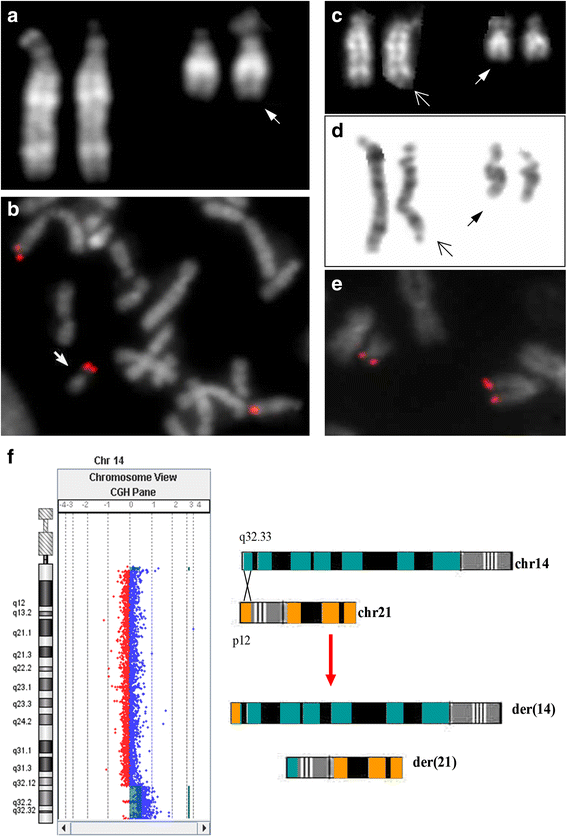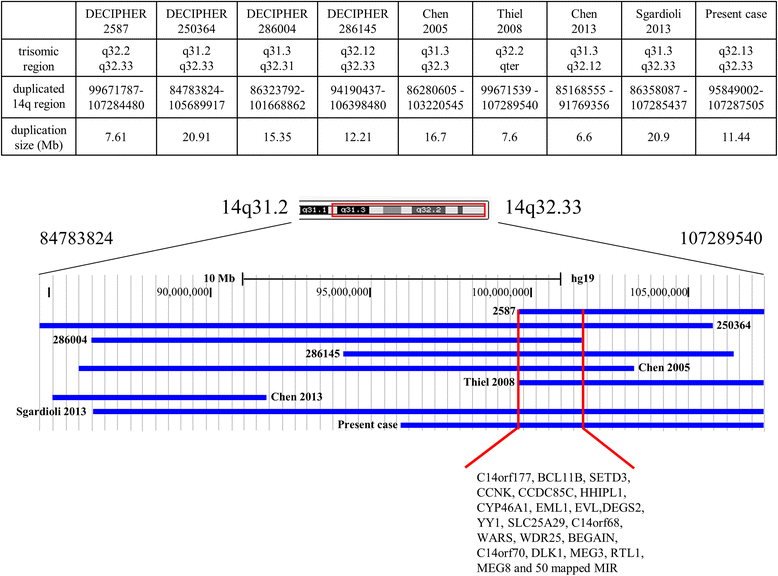14q32.3-qter trisomic segment: a case report and literature review
- PMID: 27499811
- PMCID: PMC4974715
- DOI: 10.1186/s13039-016-0265-5
14q32.3-qter trisomic segment: a case report and literature review
Abstract
Background: Segmental duplication of the long arm of chromosome 14 (14q) has commonly been reported to affect the proximal segment of 14q, while distal duplication is a rare condition and often associated with segmental monosomy of other chromosomes.
Case presentation: We report the clinical and genetic characterization of a 4-year-old male patient with 14q32.3-qter trisomy resulting from an adjacent segregation of a paternal reciprocal translocation (14;21)(q32.1;p12). The child shows minor facial anomalies, severe developmental delay, growth retardation, and a history of congenital hypothyroidism and neonatal transitory hyperglycemic crises.
Conclusions: To the best of our knowledge, only 15 other cases of segmental 14q trisomy were documented. We compared molecularly defined cases to identify a minimal common duplicated region and to find genes with a hypothetical role in the phenotype. The presented case supports the previous suggestion of a pure "distal 14q partial duplication" and underlines the clinical variability.
Keywords: 14q32.3-qter duplication; Array-CGH; Translocation (14; 21).
Figures



Similar articles
-
A child with multiple congenital anomalies due to partial trisomy 7q22.1 → qter resulting from a maternally inherited balanced translocation: a case report and review of literature.BMC Med Genomics. 2018 May 8;11(1):44. doi: 10.1186/s12920-018-0366-6. BMC Med Genomics. 2018. PMID: 29739404 Free PMC article.
-
Prenatal diagnosis and molecular cytogenetic characterization of a de novo unbalanced reciprocal translocation of der(9)t(9;14)(p24.2;q32.11) associated with 9p terminal deletion and 14q distal duplication.Taiwan J Obstet Gynecol. 2016 Aug;55(4):596-601. doi: 10.1016/j.tjog.2016.06.008. Taiwan J Obstet Gynecol. 2016. PMID: 27590390
-
[A case with partial trisomy 7 (q34→qter) derived from a paternal reciprocal translocation t(7;14)(q34;q32)].Zhonghua Yi Xue Yi Chuan Xue Za Zhi. 2011 Dec;28(6):654-7. doi: 10.3760/cma.j.issn.1003-9406.2011.06.012. Zhonghua Yi Xue Yi Chuan Xue Za Zhi. 2011. PMID: 22161098 Chinese.
-
Partial trisomy 17q22-qter and partial monosomy Xq27-qter in a girl with a de novo unbalanced translocation due to a postzygotic error: case report and review of the literature on partial trisomy 17qter.Am J Med Genet. 1997 May 2;70(1):87-94. doi: 10.1002/(sici)1096-8628(19970502)70:1<87::aid-ajmg16>3.0.co;2-t. Am J Med Genet. 1997. PMID: 9129747 Review.
-
Distal trisomy 14q. I. Clinical and cytogenetical studies.Hum Genet. 1990 Oct;85(6):612-6. doi: 10.1007/BF00193584. Hum Genet. 1990. PMID: 2227953 Review.
Cited by
-
A Recurrent De Novo Terminal Duplication of 14q32 in Korean Siblings Associated with Developmental Delay and Intellectual Disability, Growth Retardation, Facial Dysmorphism, and Cerebral Infarction: A Case Report and Literature Review.Genes (Basel). 2021 Sep 7;12(9):1388. doi: 10.3390/genes12091388. Genes (Basel). 2021. PMID: 34573370 Free PMC article. Review.
-
Clinical and molecular characterization of 12 prenatal cases of Cri-du-chat syndrome.Mol Genet Genomic Med. 2020 Aug;8(8):e1312. doi: 10.1002/mgg3.1312. Epub 2020 Jun 4. Mol Genet Genomic Med. 2020. PMID: 32500674 Free PMC article.
-
Congenital hyperinsulinemic hypoglycaemia in an infant with 9p deletion syndrome.Ann Pediatr Endocrinol Metab. 2025 Apr;30(2):102-105. doi: 10.6065/apem.2448132.066. Epub 2025 Apr 30. Ann Pediatr Endocrinol Metab. 2025. PMID: 40335045 Free PMC article. No abstract available.
-
Instability of Short Arm of Acrocentric Chromosomes: Lesson from Non-Acrocentric Satellited Chromosomes. Report of 24 Unrelated Cases.Int J Mol Sci. 2020 May 13;21(10):3431. doi: 10.3390/ijms21103431. Int J Mol Sci. 2020. PMID: 32413994 Free PMC article.
References
-
- Lledó B, Ortiz JA, Morales R, Ten J, de la Fuente PE, et al. The paternal effect of chromosome translocation carriers observed from meiotic segregation in embryos. Hum Reprod. 2010; 25(7):1843-8.3. - PubMed
-
- Orye E, Van Bever H, Desimpel H. Distal trisomy 14q due to tandem duplication (q24 → q32) Ann Genet. 1983;26:238–239. - PubMed
Publication types
LinkOut - more resources
Full Text Sources
Other Literature Sources

